Airport Classification and Planning in Virginia
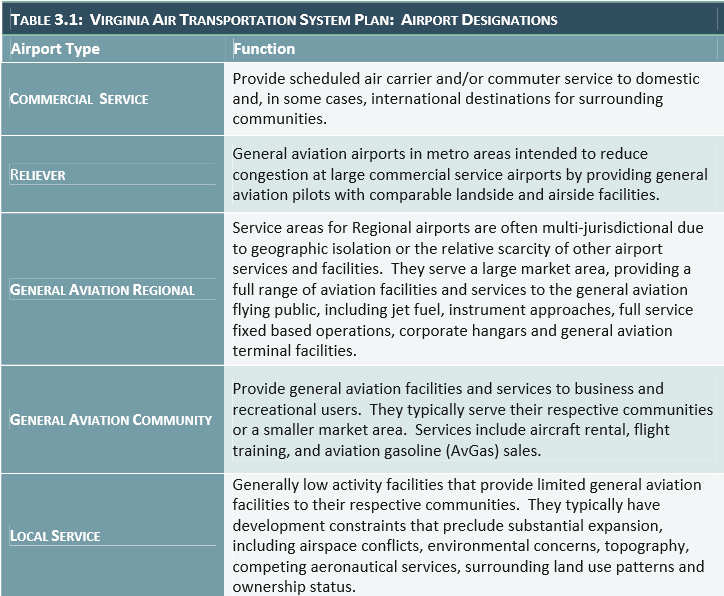
the state classification system for airports is different from the Federal Aviation Administration's National Plan of Integrated Airport Systems (NPIAS)
Source: Virginia Department of Aviation, Competitive Analysis of Virginia's Aviation Industry (Table 3.1)
The Virginia Department of Aviation has classified 66 public use airports based on their economic and transportation roles. In addition to the 9 Commercial Service airports with airlines carrying passengers, there are 8 Reliever airports, 19 General Aviation Regional airports, 16 General Aviation Community airports, and 14 Local Service airports. There are 65 hospital heliports as well.
An additional 11 airports support military operations. The largest is Naval Air Station Norfolk (Chambers Field), Air Cargo Transport Hub for the US Navy. Marine Corps Base Quantico hosts the helicopter fleet for the White House, and Fort Pickett supports Unmanned Aerial Systems (UAS) research and development.1
The state agency calculated in 2016 that 77.5% of the Virginia population was within a 45-minute drive of a Virginia airport offering scheduled passenger flights, and another 1.1% were near an equivalent out-of state airport. It noted:2
- Based on individual needs and circumstances, passengers will drive up to 120 minutes to reach a departure airport. When drive times to all Commercial Service airports in Virginia and neighboring states are increased to 120 minutes, almost 100 percent of Virginia's residents are within the service area of one or more Commercial Service airports.
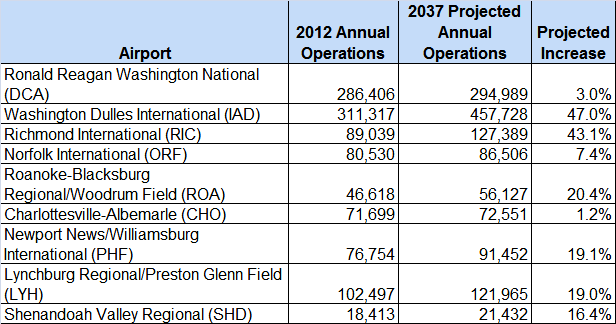
airports with scheduled passenger service are predicted to see different increases in the number of takeoffs and landings (operations) by 2037
Source: Virginia Department of Aviation, Virginia Air Transportation System Plan Update (2016) (Table 3-14)
The Federal Aviation Administration (FAA) has identified 3,332 airports in the United States that meet Federal design standards, and classified each facility in the National Plan of Integrated Airport Systems (NPIAS). Inclusion on that list is required for an airport to obtain Federal Airport Improvement Program (AIP) funding for airport improvements. The Federal Aviation Administration listed 47 Virginia airports in the 2017-21 report.
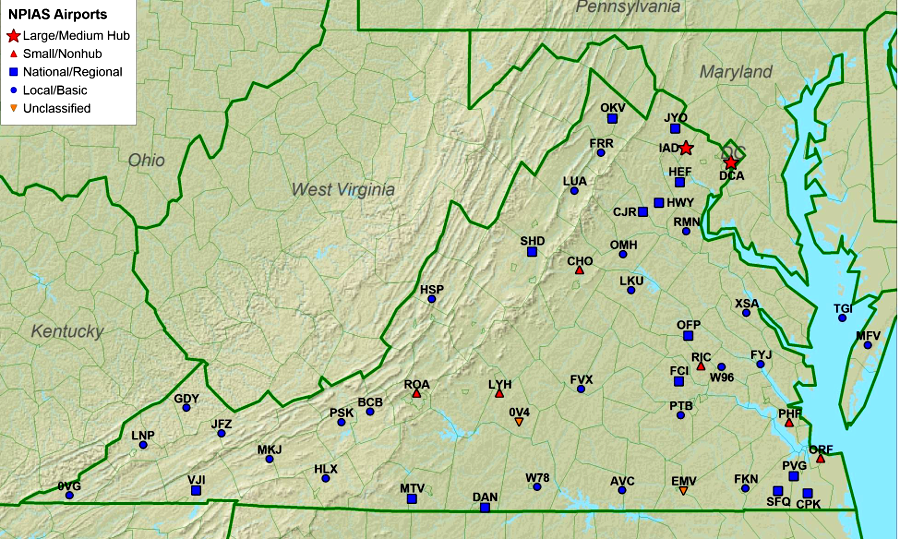
47 Virginia airports are listed in the National Plan of Integrated Airport Systems (NPIAS)
Source: Federal Aviation Administration, 2017-21 National Plan of Integrated Airport Systems (NPIAS) Report
Dulles International Airport (IAD) and Reagan National Airport (DCA) are the only two in Virginia classified by the Federal Aviation Administration in the National Plan of Integrated Airport Systems as "Primary, Large-Hub" airports. Those two airports exceed the threshold of at least 1% of total passenger boardings within the United States.
Norfolk International Airport (ORF) and Richmond International Airport (RIC) meet the National Plan of Integrated Airport Systems (NPIAS) criteria to be classified as "Primary, Small-Hub" airports. They have at least 0.05%, but less than 0.25%, of the total passenger boardings within the United States.
Four other Virginia airports with scheduled passenger service are categorized as "Primary, Non-Hub" facilities. Charlottesville Albemarle Airport (CHO), Lynchburg Regional Airport (LYH), Roanoke-Blacksburg Regional Airport (ROA), and Newport News/Williamsburg International Airport (PHF) have more than 10,000 passenger boardings each year but less than 0.05% of total passenger boardings within the United States.
The least-used airport with scheduled passenger service in Virginia, Shenandoah Valley Regional Airport (SHD), is classified as "Nonprimary, Nonhub." Airports in that category offer commercial service, and have at least 2,500 and no more than 10,000 passenger boardings each year.3
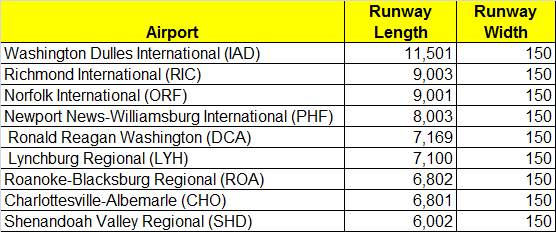
Shenandoah Valley Regional Airport (SHD) has the shortest runway of the nine airports in Virginia that offer scheduled passenger service
Source: Virginia Department of Aviation, Virginia Air Transportation System Plan Update (Table 3-12)
The Federal Aviation Administration's "2017-21 National Plan of Integrated Airport Systems (NPIAS) Report" identifies the 8 Virginia airports carrying the most passengers as National because they provide communities with access to national and international markets in multiple states and throughout the United States.4

the Federal Aviation Administration categorized 8 Virginia airports as having a "national" role in the national aviation system
Source: Federal Aviation Administration, List of NPIAS Airports with 5-Year Forecast Activity and Development Cost (Appendix A)
An additional 13 airports, including Shenandoah Valley Regional Airport (SHD), were classified as Regional. They supports regional economies by connecting communities to statewide and interstate markets..
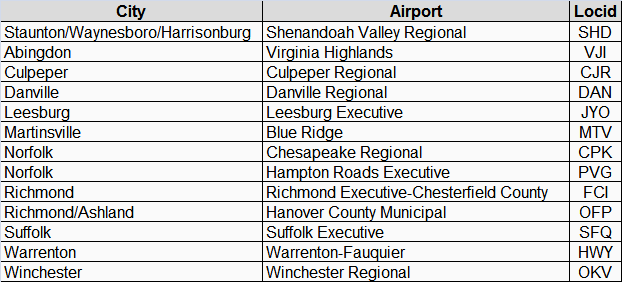
the Federal Aviation Administration categorized 13 Virginia airports as having a "regional" role in the national aviation system
Source: Federal Aviation Administration, List of NPIAS Airports with 5-Year Forecast Activity and Development Cost (Appendix A)
16 airports were categorized as Local, with their role as providing access to primarily intrastate and some interstate markets.

the Federal Aviation Administration categorized 16 Virginia airports as having a "local" role in the national aviation system
Source: Federal Aviation Administration, List of NPIAS Airports with 5-Year Forecast Activity and Development Cost (Appendix A)
8 airports were listed as Basic, because they supported general aviation activities (e.g., emergency services, charter or critical passenger service, cargo operations, flight training and personal flying.

the Federal Aviation Administration categorized 8 Virginia airports as having a "basic" role in the national aviation system
Source: Federal Aviation Administration, List of NPIAS Airports with 5-Year Forecast Activity and Development Cost (Appendix A)
Two others, Brookneal/Campbell County and Emporia-Greensville Regional, were Unclassified due to their limited activity.

the Federal Aviation Administration categorized 8 Virginia airports as having a "basic" role in the national aviation system
Source: Federal Aviation Administration, List of NPIAS Airports with 5-Year Forecast Activity and Development Cost (Appendix A)
46 of the 47 Virginia airports listed in the "2017-21 National Plan of Integrated Airport Systems (NPIAS) Report" are owned by public agencies. Some, such as the Manassas Airport, were originally built by private investors in 1932. The Town of Manassas purchased it in 1945, and relocated the airport to its current site in 1964.
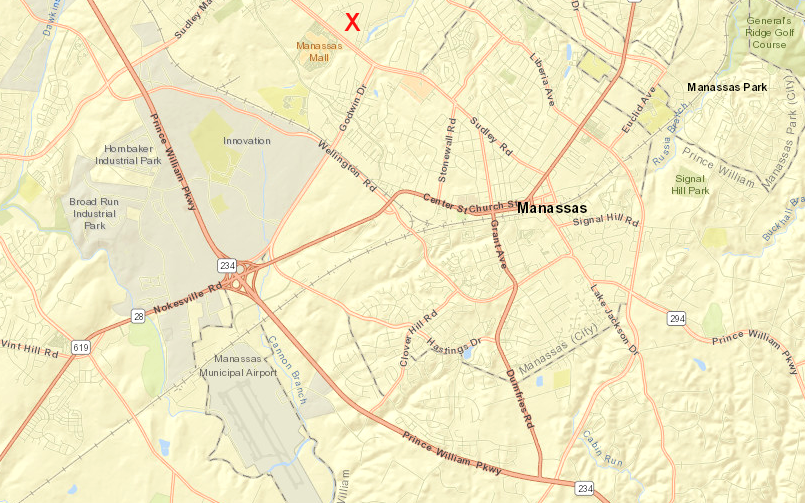
the original airport for Manassas, developed by private investors, is now the Manaport Shopping Center (red X) across the street from Manassas Mall
Source: ESRI, ArcGIS Online
All Virginia airports listed in the National Plan of Integrated Airport Systems and classified as "Reliever" are now publicly-owned facilities, with the exception of the Hampton Roads Executive Airport (KPVG). That facility is privately owned by the Virginia Aviation Associates.5
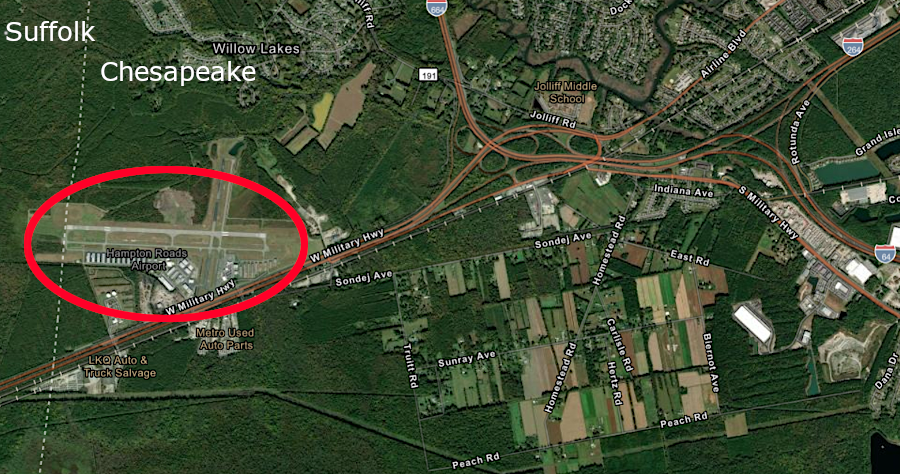
the Hampton Roads Executive Airport is located on the western edge of the City of Chesapeake
Source: ESRI, ArcGIS Online
State and Federal funding for airports is used to expand capacity, to improve safety, and to reduce noise and other environmental impacts. Terminal expansions are typically funded by Passenger Facility Charges, fees added to each ticket. Airports with more passengers can generate more funding and expand/upgrade terminals, even if they fail to obtain Federal Airport Improvement Program grants.
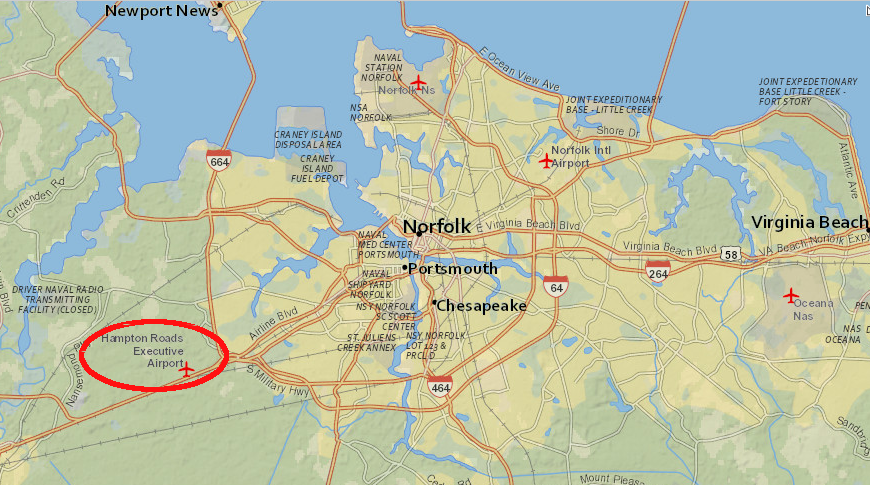
the Hampton Roads Executive Airport is the only privately-owned Virginia airport listed on the National Plan of Integrated Airport Systems and thus eligible for Federal funding
Source: ESRI, ArcGIS Online
The Federal Aviation Administration identifies 461 airports in Virginia, including 414 that are not listed in the National Plan of Integrated Airport Systems and therefore not eligible for Airport Improvement Program funding. 210 of those airports have paved runways. Four sites have "water" identified for the runway, including Lockerman at Smith Mountain Lake.6
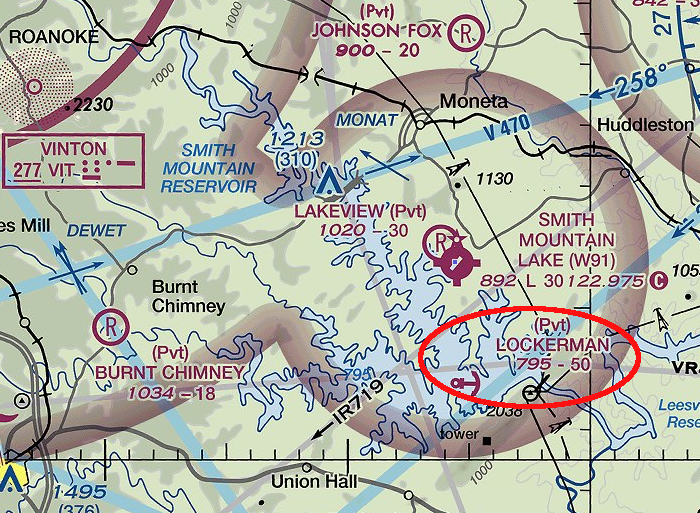
Smith Mountain Lake serves as an airport for seaplanes
Source: VFR MAP
Cargo is delivered by planes at all Virginia airports. Small planes can deliver business papers to even the Brookneal/Campbell County and Emporia-Greensville Regional Unclassified airports, but four in Virginia receive the majority of air freight.7

four Virginia airports receive the greatest amount of air freight
Source: Federal Aviation Administration, Passenger Boarding (Enplanement) and All-Cargo Data for U.S. Airports
The Virginia Department of Aviation considers more factors, especially the economic role of airports for General Aviation, than the Federal Aviation Administration's National Plan of Integrated Airport Systems (NPIAS). Like the Federal government, the state also uses the classification system to set a threshold for which airports may receive state government funding. Airports designated "Local" are not eligible for state funding, except for except for safety and preservation projects.
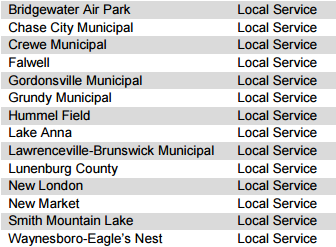
14 airports designated "Local" by the Virginia Department of Aviation have limited access to state funding
Source: Virginia Department of Aviation, Virginia Air Transportation System Plan Update (Table 3-4)
All other airports can obtain state funding to upgrade infrastructure. For airports not designated "Local" and with more than 500 annual jet operations, the state objective is to upgrade runway lengths to 5,500 feet. As of 2016, 17 airports needed to extend their runways to meet that state standard.8

as of 2016, 17 airports needed to extend their runways to meet the minimum state standard of 5,500 feet
Source: Virginia Department of Aviation, Virginia Air Transportation System Plan Update (p.122)
The 2016 Virginia Air Transportation System Plan Update identified numerous opportunities for airports to improve pavement strength, access to fuel, ground-level transportation, and terminals. More significantly, the Virginia Department of Aviation identified which upgrades were required to meet safety standards.

to meet state standards, an airport must have ownership or easements that control development within the entire Runway Protection Zone (RPZ)
Source: Virginia Department of Aviation, Virginia Air Transportation System Plan Update (Figure 3-29)
The Virginia Department of Aviation also defined a Business Class airport, part of its efforts to ensure service for executives using general aviation business jets and to enhance economic development within the state.
The Federal Aviation Administration has no such Business Class designation. In Virginia, a Business Class airport has three characteristics:9
- a runway that is 5,500 feet long or longer
- a precision approach that is supported by vertical guidance
- on-site weather reporting equipment
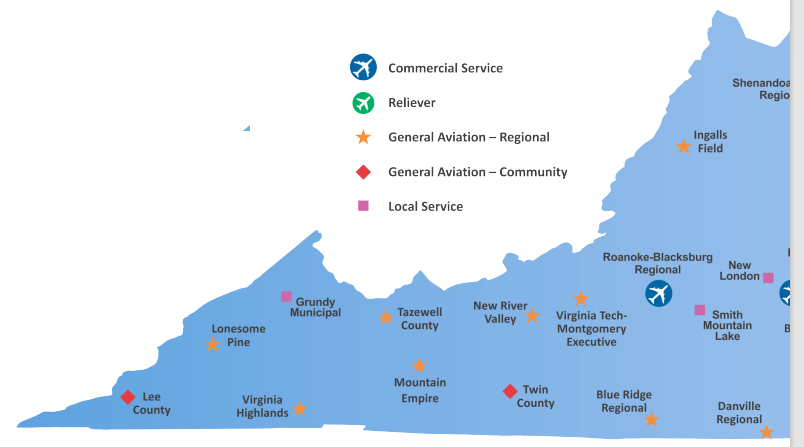
airports in Southwest Virginia
Source: Virginia Department of Aviation, 2018 Virginia Airport System Economic Impact Study (p.7)
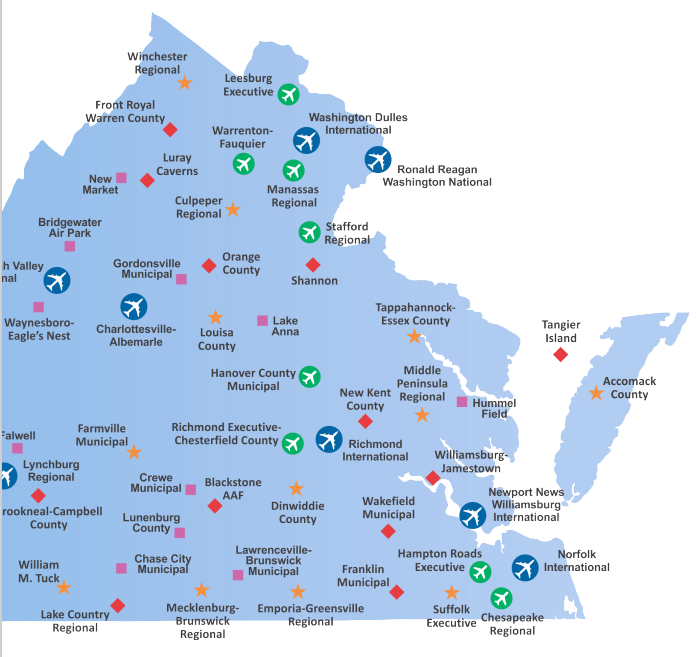
airports in eastern Virginia
Source: Virginia Department of Aviation, 2018 Virginia Airport System Economic Impact Study (p.8)
While over 70% of Virginia residents live within a 30-minute drive of a Business Class airport, there are geographic gaps. The Appalachian Plateau, Southside, and the Northern Neck are underserved compared to other parts of Virginia.
The Virginia Department of Aviation has recommended upgrading 10 existing airports, building three new ones in the Northern Neck/Franklin County-Rocky Mount/Lexington-Rockbridge County areas, and building a new Breaks Regional Airport to replace Grundy Municipal Airport. The state agency argues that the costs would be justified by the benefits from increased business activity:10
- Given the role of business class airports to serve and contribute to economic growth, the status quo alternative would not be viable for a state focused on improving its economic environment and the infrastructure that supports business growth.
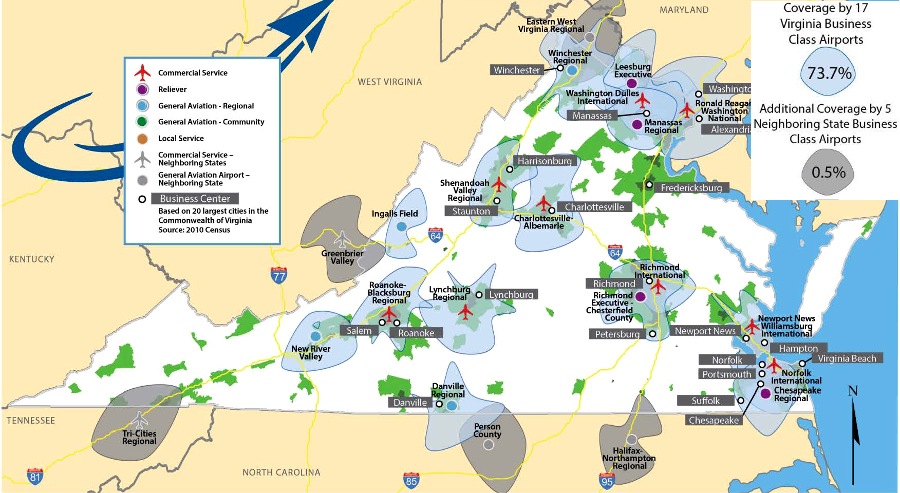
Southwestern Virginia lacks easy access to a Business Class airport
Source: Virginia Department of Aviation, Virginia Air Transportation System Plan Update (2016), Current Access to Business Class Airports (Figure 4-6)
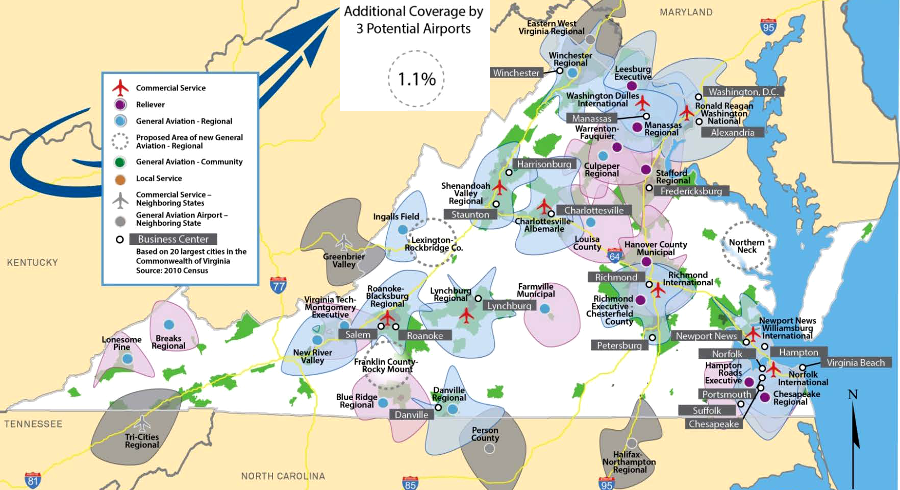
Virginia could increase the number of Business Class airports by upgrading existing General Aviation airports, constructing three new ones, and replacing Grundy Municipal Airport with Breaks Regional Airport
Source: Virginia Department of Aviation, Virginia Air Transportation System Plan Update (2016), Future Access to Business Class Airports (Figure 4-12)
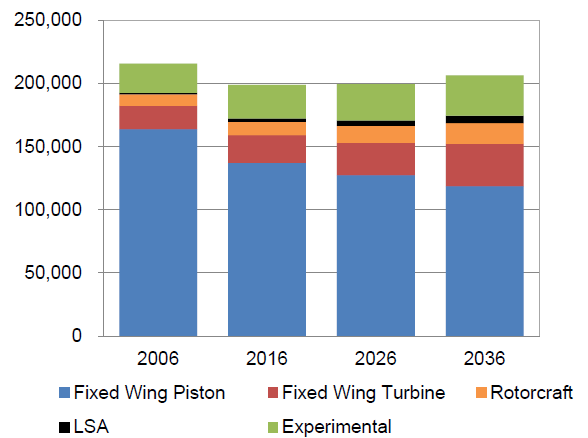
Virginia plans to upgrade airports to service more turbine-powered jets, as they replace piston-driven aircraft in the General Aviation fleet (LSA=Light Sport Aircraft)
Source: Federal Aviation Administration, FAA Aerospace Forecast (2016-2036) (p.23)
Links
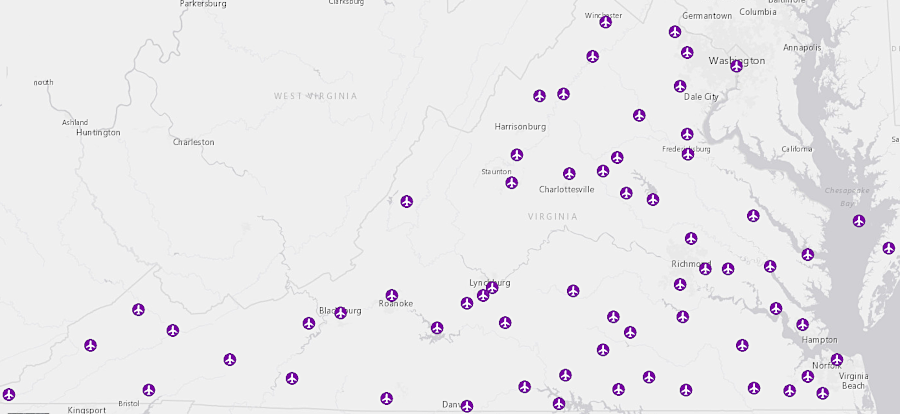
general aviation and commercial service airports in Virginia
Source: Office of Intermodal Planning and Investment, InteractVTrans
References
1. "Virginia Air Transportation System Plan Update - Facility Objectives Analysis," Virginia Department of Aviation, 2016, pp.169-171, http://www.doav.virginia.gov/Downloads/Studies/VATSP%20Update%202016/600%20DOAVAS%2020160406%20VATSP%20Update-04%20Chapter%203%20Facility%20Objectives_Web_acsbl.pdf; "Competitive Analysis of Virginia's Aviation Industry," Virginia Department of Aviation, January 2012, p.7, pp.9-10, http://doav.virginia.gov/Downloads/Studies/Competitive%20Analysis/DOAVAviationCompetitiveAnalysisRevised.pdf (last checked December 21, 2016)
2. "Virginia Air Transportation System Plan Update - Executive Summary," Virginia Department of Aviation, 2016, pp.6-8, http://www.doav.virginia.gov/Downloads/Studies/VATSP%20Update%202016/600%20DOAVAW%2020160406%20VATSP%20Update%20-%20Executive%20Summary_Web_acsbl.pdf (last checked December 21, 2016)
3. "Virginia Air Transportation System Plan Update - Facilities Objectives Analysis," Virginia Department of Aviation, 2016, pp.98-99, http://www.doav.virginia.gov/Downloads/Studies/VATSP%20Update%202016/600%20DOAVAS%2020160406%20VATSP%20Update-04%20Chapter%203%20Facility%20Objectives_Web_acsbl.pdf; "Airport Categories," Federal Aviation Administration, https://www.faa.gov/airports/planning_capacity/passenger_allcargo_stats/categories/
4. "List of NPIAS Airports with 5-Year Forecast Activity and Development Cost (Appendix A)," Federal Aviation Administration, https://www.faa.gov/airports/planning_capacity/npias/reports/media/NPIAS-Report-2017-2021-Appendix-A.xlsx (last checked December 23, 2016)
5. "Appendix A: List of NPIAS Airports, National Plan of Integrated Airport Systems (2023-2027)," Federal Aviation Administration (FAA), September 30, 2022, pp.A124-A125, https://www.faa.gov/airports/planning_capacity/npias/current; "About KPVG," Hampton Roads Executive Airport, https://www.flypvg.com/about (last checked August 5, 2024)
6. "Airport Runways Data," Federal Aviation Administration, (last checked December 24, 2016)
7. "Qualifying Cargo Airports, Rank Order, and Percent Change from 2014," Federal Aviation Administration, https://www.faa.gov/airports/planning_capacity/passenger_allcargo_stats/passenger/media/cy15-cargo-airports.xlsx (last checked December 23, 2016)
8. "Virginia Air Transportation System Plan Update (2016)," Virginia Department of Aviation, p.100, http://www.doav.virginia.gov/VATSP_update_2016.htm (last checked December 23, 2016)
9. "Virginia Air Transportation System Plan Update (2016)," Virginia Department of Aviation, p.262, http://www.doav.virginia.gov/VATSP_update_2016.htm (last checked December 23, 2016)
10. "Virginia Air Transportation System Plan Update (2016)," Virginia Department of Aviation, p.282, http://www.doav.virginia.gov/VATSP_update_2016.htm (last checked December 23, 2016)
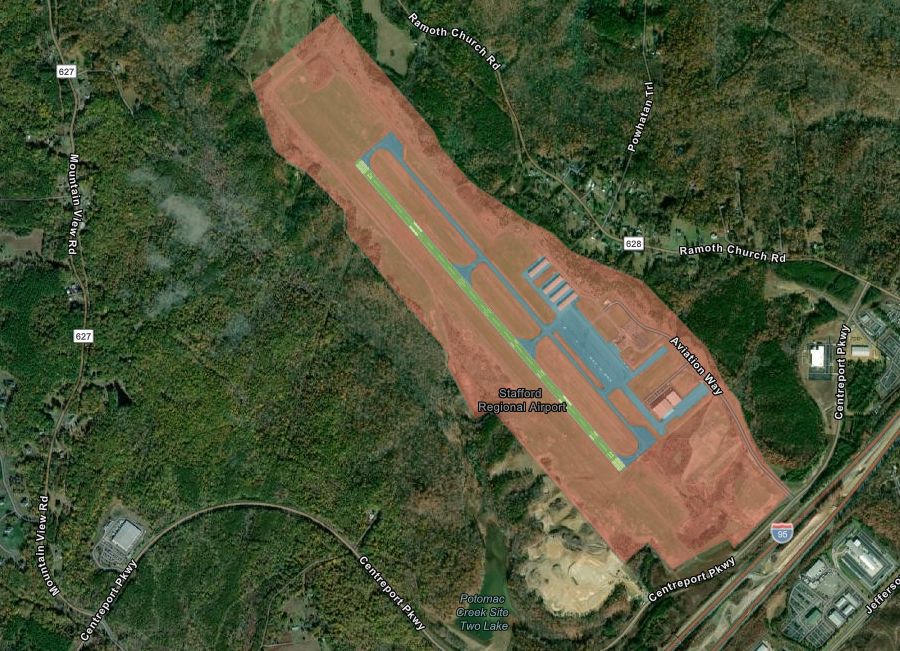
Stafford Regional Airport is a "reliever" that provides high-quality services general aviation operators to reduce congestion at nearby commercial service airports
Source: ESRI, ArcGIS Online with Virginia Airport Dataset
Transportation: From Feet to Teleports
Virginia Places























